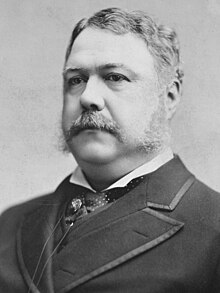Chester Arthur
| Chester A. Arthur | |
|---|---|
 |
|
| 21st President of the United States | |
|
In office September 19, 1881 – March 4, 1885 |
|
| Vice President | None |
| Preceded by | James A. Garfield |
| Succeeded by | Grover Cleveland |
| 20th Vice President of the United States | |
|
In office March 4, 1881 – September 19, 1881 |
|
| President | James A. Garfield |
| Preceded by | William A. Wheeler |
| Succeeded by | Thomas A. Hendricks |
| 10th Chairman of the New York State Republican Executive Committee | |
|
In office September 11, 1879 – October 11, 1881 |
|
| Preceded by | John F. Smyth |
| Succeeded by | B. Platt Carpenter |
| 21st Collector of the Port of New York | |
|
In office December 1, 1871 – July 11, 1878 |
|
| Appointed by | Ulysses S. Grant |
| Preceded by | Thomas Murphy |
| Succeeded by | Edwin Atkins Merritt |
| Engineer-in-Chief of the New York Militia | |
|
In office January 1, 1861 – January 1, 1863 |
|
| Preceded by | George F. Nesbitt |
| Succeeded by | Isaac Vanderpoel |
| Inspector General of the New York Militia | |
|
In office April 14, 1862 – July 12, 1862 |
|
| Preceded by | Marsena R. Patrick |
| Succeeded by | Cuyler Van Vechten |
| Quartermaster General of the New York Militia | |
|
In office July 27, 1862 – January 1, 1863 |
|
| Preceded by | Cuyler Van Vechten |
| Succeeded by | Sebastian Visscher Talcott |
| Personal details | |
| Born |
October 5, 1829 Fairfield, Vermont, U.S. |
| Died | November 18, 1886 (aged 57) Manhattan, New York, U.S. |
| Resting place |
Albany Rural Cemetery Menands, New York, U.S. |
| Political party | Republican (1854–86) |
| Other political affiliations |
Whig (Before 1854) |
| Spouse(s) | Ellen Herndon (m. 1859; d. 1880) |
| Children | 3, including Chester II |
| Education | |
| Profession |
|
| Religion | Episcopal |
| Signature | |
| Military service | |
| Allegiance | |
| Service/branch |
|
| Years of service | 1857–1863 |
| Rank |
|
| Unit | Second Brigade, New York Militia Staff of Governor Edwin D. Morgan |
| Battles/wars | American Civil War |
| The Arthur Cabinet | ||
|---|---|---|
| Office | Name | Term |
| President | Chester A. Arthur | 1881–85 |
| Vice President | None | 1881–85 |
| Secretary of State | James G. Blaine | 1881 |
| Frederick T. Frelinghuysen | 1881–85 | |
| Secretary of Treasury | William Windom | 1881 |
| Charles J. Folger | 1881–84 | |
| Walter Q. Gresham | 1884 | |
| Hugh McCulloch | 1884–85 | |
| Secretary of War | Robert T. Lincoln | 1881–85 |
| Attorney General | Wayne MacVeagh | 1881 |
| Benjamin H. Brewster | 1881–85 | |
| Postmaster General | Thomas L. James | 1881 |
| Timothy O. Howe | 1881–83 | |
| Walter Q. Gresham | 1883–84 | |
| Frank Hatton | 1884–85 | |
| Secretary of the Navy | William H. Hunt | 1881–82 |
| William E. Chandler | 1882–85 | |
| Secretary of the Interior | Samuel J. Kirkwood | 1881–82 |
| Henry M. Teller | 1882–85 | |
Chester Alan Arthur (October 5, 1829 – November 18, 1886) was an American attorney and politician who served as the 21st President of the United States (1881–85); he succeeded James A. Garfield upon the latter's assassination. At the outset, Arthur struggled to overcome a slightly negative reputation, which stemmed from his early career in politics as part of New York's Republican political machine. He succeeded by embracing the cause of civil service reform. His advocacy for, and subsequent enforcement of, the Pendleton Civil Service Reform Act was the centerpiece of his administration.
Arthur was born in Fairfield, Vermont, grew up in upstate New York, and practiced law in New York City. He served as quartermaster general in the New York Militia during the American Civil War. Following the war, he devoted more time to Republican politics and quickly rose in the political machine run by New York Senator Roscoe Conkling. Appointed by President Ulysses S. Grant to the lucrative and politically powerful post of Collector of the Port of New York in 1871, Arthur was an important supporter of Conkling and the Stalwart faction of the Republican Party. In 1878, the new president, Rutherford B. Hayes, fired Arthur as part of a plan to reform the federal patronage system in New York. When Garfield won the Republican nomination for president in 1880, Arthur, an eastern Stalwart, was nominated for vice president to balance the ticket.
...
Wikipedia
